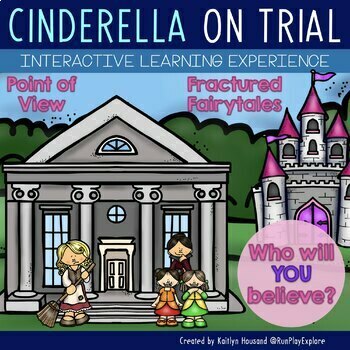Cinderella on Trial (Fractured Fairy Tales/Point of View)
- PDF
What educators are saying
Also included in
- Point of view can be difficult for students to grasp. With this unit, you'll teach POV using fractured fairytales and hold a mock trial where your students will put fairy tale characters on trial. You'll set up court, act as judge and jury, and decide which perspective is the most believable.The FaiPrice $15.25Original Price $30.50Save $15.25
Description
Point of view can be difficult for students to grasp. With this unit, you'll teach POV using fractured fairytales and hold a mock trial where your students will put fairy tale characters on trial. You'll set up court, act as judge and jury, and decide which perspective is the most believable.
Cinderella on Trial
Cinderella was just an innocent young girl whose life was almost ruined by her terrible step mother and step sisters. Or was she? Your students will decide when you read two different versions of the story. Use any original version and any fractured/alternate version. I recommend "Seriously, Cinderella is SO Annoying" told by none other than the "Wicked" Step Mother herself!
The Cinderella on Trial packet includes 7 student roles and a "You Be The Juror" sheet that allows students to think critically about their classmates' testimonies as they listen.
*************************************************************************************************************
The Fairytales on Trial Bundle is the best value, and includes two weeks of lesson plans, suggested point of view picture books that teach perspective, explicit instructions for separating your students into groups and implementing the activity, and NINE different trials to use in your classroom.
The bundle also includes a rubric for grading the project and a themed Venn diagram to compare and contrast the fractured fairytale to the classic version. Both the bundle and the individual fairytale trials come with a “You Be the Juror” sheet which allows students who are watching the trials to listen and judge which character’s testimony is the most believable.
If you’re simply looking for the basics, you can find the individual trials below without all these extras:
This unit teaches and reviews point of view of literary text characters, perspective, comparing and contrasting, speaking and listening, and critical thinking. Students will refer back to the text for evidence as they write their testimonies in complete sentences in the first-person, and listen for evidence while they’re acting as jurors. Students will analyze characters’ thoughts, actions, and character traits.
It is highly recommended that you have hard copies of the books that you’ll use for the units and can share with the students. A suggested list of books is included in the bundle.
In addition, the bundle includes the Point of View Mystery Box activity to introduce this abstract concept in a simple and engaging way.





